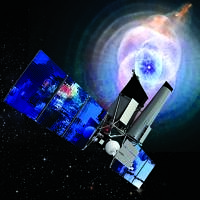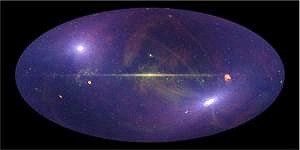Computer programs for a celestial eye

FAU researchers support space mission with software and data analysis
On 21 June, 14:17 Central European Summer Time, when a Proton M rocket launches in the Russian space port of Baikonur to bring the eROSITA X-ray telescope into space on board the SRG satellite, a piece of FAU know-how will also be on board. Astronomers from the Dr. Karl Remeis Observatory at the Friedrich Alexander University Erlangen-Nürnberg (FAU) helped develop the telescope with special software for mathematical models. But also during the seven-year mission, the team around Prof. Dr. Jörn Wilms, Professor of Astronomy and Astrophysics, will take over an important part of the analysis of the measurement data collected by eROSITA.
Search for dark energy
To unravel the mystery of dark energy, several research institutions, including FAU, have collaborated under the leadership of the Max Planck Institute for Extraterrestrial Physics (MPE) to develop an X-ray telescope. With its seven identical mirror modules, it will be possible to examine the starry sky precisely in the mid X-ray range and map around 100,000 galaxy clusters in order to be able to make statements about the development of that mysterious dark energy that is driving the universe ever faster apart. The researchers also hope to gain insights into millions of active galaxy nuclei containing black holes, as well as observations of double stars and remnants of star explosions. However, eROSITA will not orbit the Earth in one orbit for this purpose, but one of the so-called Lagrange points at a distance of about 1.5 million kilometres from the Earth. The advantage at this point is the telescope retains its orientation in relation to the Sun and Earth.
Simulations and analysis
For the eROSITA programme, the FAU astronomers are responsible for the initial control and monitoring of the satellite data. This, in particular, includes near-real-time analysis. For this purpose, a control room has been set up in the Dr. Karl Remeis Observatory. There, conspicuous measured values are immediately checked and compared with existing data. “If it is a previously unknown source or if a known object behaves unexpectedly because, for example, it glows a hundred times brighter than expected, we send a message to colleagues worldwide,” Wilms explains. “They can then use telescopes like the Hubble Space Telescope or the Chandra Telescope to investigate our clue.”

The FAU astronomers also contributed special software to the preparation of the mission for this international project. The computer program is designed in such a way that it can easily be adapted to any possible space mission. It can model what the mission will observe, depending on the mission objective. In this way, the performance of measuring instruments such as the eROSITA X-ray telescope can be optimized. During the mission, these simulations serve as a check to compare the observations with the expectations. “If a value deviates far from what we expect, then we have to check whether something is damaged,” Wilms explains. With this software, FAU researchers are in great demand. They are also part of the ATHENA mission of the European Space Agency ESA.
International Cooperation
The eROSITA project involves the MPE and FAU, the Institute of Astronomy and Astrophysics of the University of Tübingen, the Leibniz Institute of Astrophysics Potsdam (AIP), the Observatory of the University of Hamburg, the Russian Space Agency Roskosmos and the German Aerospace Center (DLR), as well as the University Observatory of the Ludwig Maximilian University Munich (LMU) and the Argelander Institute of Astronomy, University of Bonn. The Russian partner institute is the Space Research Institute IKI in Moscow; NPOL, Lavochkin Association, Khimky near Moscow, is technically responsible for the entire SRG mission.
Further information can be found on the following pages:
Dr. Karl Remeis Observatory of the FAU
Max Planck Institute for Extraterrestrial Physics (MPE)
Further informations
Prof. Dr. Jörn Wilms
Phone: 0951/95222-13
joern.wilms@sternwarte.uni-erlangen.de
(due to the start of eROSITA only available until 19.6., 11:00 a.m.)
Prof. Dr. Manami Sasaki
Phone: 0951/95222-19
manami.sasaki@fau.de